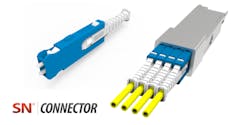Senko charts progress of SN connector, transceiver adoption
Senko Advanced Components, Inc. has announced major advancements in the adoption and continued deployment of its SN Connector technology and supporting ecosystem after two years of field trials.
Currently, Senko has licensed its technology out to leading transceiver and connector manufacturers, including Applied Optoelectronics Inc., Cisco, Delta, Eoptolink, Innolight, Juniper Networks, Molex, and Sicoya. Support equipment and products, such as production and field equipment, testers, and cleaning and inspection tools are now fully supported, as Senko has been working with the various suppliers to ensure the continued adoption of the SN form factor.
Jim Hasegawa, executive vice president of Senko, commented, “Senko is pleased to license SN technologies out to all these companies. With the support from them and other suppliers working on SN connectors, we foresee SN to be adopted in numerous applications, including DCI and wireless fronthaul connectivity, especially with the standardization effort of the SN at the IEC. We express our deepest appreciation and gratitude to all our partners for their expert support and also their trust in the SN technology."
The SN connector is a new, duplex optical fiber connector using LC style 1.25mm O.D. Zirconia ferrules, designed for next generation hyperscale data center interconnect (DCI). This connector was designed to provide individual and independent duplex fiber breakout at a quad style transceiver (QSFP, QSFP-DD and OSFP) that Senko contends is not only more efficient, reliable and scalable than the MPO connector but also at a lower in cost to implement. The SFP-DD has also adopted the SN as their independent duo style interface, mainly for the wireless fronthaul applications.
The manufacturer notes that one of the major topologies in hyperscale DCI is the Leaf-Spine, which is required to create a cross-connection between leaf and spine switches. The structure of the Leaf-Spine data center network is typically made by the use of the MPO and LC breakout cables, or fiber shuffle boxes between switches.
Senko maintains that its SN connector can simplify and reduce the overall cost of this structure, as SN-based transceivers are already divided into four (4) individual SN connectors at the transceiver interface. Only SN to SN jumpers are required to make a mesh fabric cross-connection, connecting from point to point at the transceiver.
Compared to an LC connector, Senko notes the SN form factor can reach ultra high-density at patch panel applications. While LC solutions get up to 144F within a 1RU patch panel, SN can increase the fiber counts to 432F in a 1RU panel. In a single 45 RU rack, one is able to terminate in excess of 14,000 fiber cores.
Learn more at at www.senko.com.
